With help from Tony himself, and from Martin de la Harpe, here is the story of this historic trip as published in the August 1989 Popular Flying Association (PFA) magazine.
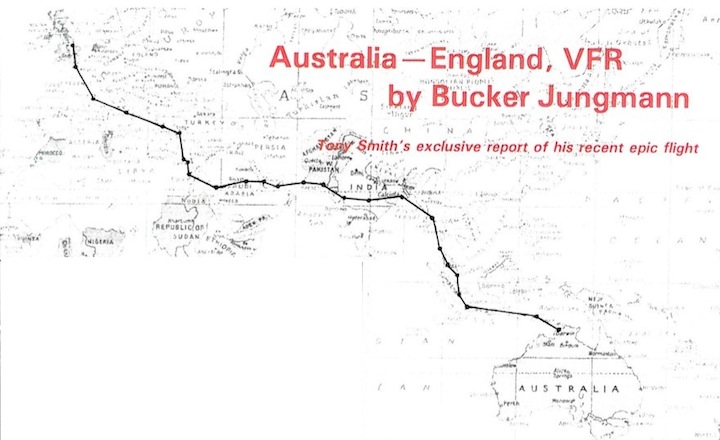
In the thirties, England seemed full of pioneering men and women aviators, trailblazing their way to all parts of the globe in aircraft that most of us today would consider totally inadequate for such ordeals. Some made it successfully, usually against huge odds, becoming household names in the process. Others failed, often paying the ultimate price and disappearing into obscurity.
The advent of war left no time for the luxuries of record breaking and the Kingsford Smiths, C.W.A. Scotts and Mollisons became history and folklore. Being a lifelong aviation freak (I was 43 at the time this was written in 1989), my childhood heroes were those kind of folk and I have always wondered what inspired and drove them on.
In 1984, after a few years of defacing cliffs with my teeth during hang gliding escapades, my wife decided I should learn to fly real aeroplanes. Six months later I was flying my own Super Cub and loving every minute when Neil Williams inspired me with his article on the Bucker Jungmann; the search was on!
I eventually found a CASA 131 (Spanish built example) for sale at Elstree. This was the subject of an extensive restoration by Hornet Aviation at Selby and 18 months later G-TAFF was rolled out in her present livery. Two years of fun and aeros with the British Aerobatic Association left me wondering about a long distance flight. After a disastrous engine failure in December ‘87, I decided to fit a zero-houred replacement (ENMA Tigre GIVB) and to modify the aircraft extensively to get maximum range.
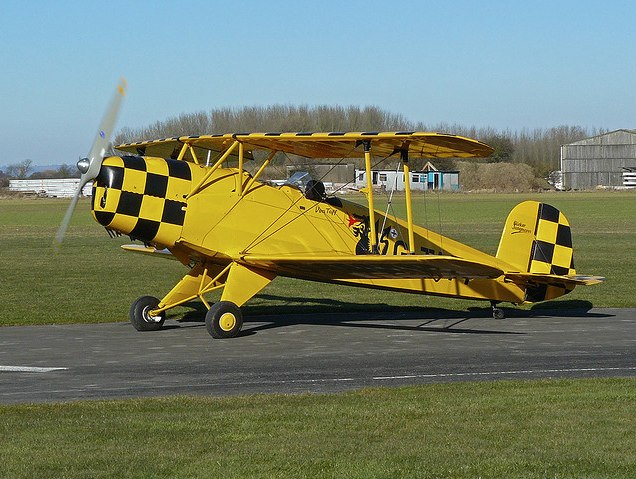
I obtained a 200 hour engine from the States for £900 (including shipping!) and handed this over to Norvic Racing Engines to strip and zero. All dual controls, front seat and inverted fuel and oil systems were taken out. Two extra ferry tanks were manufactured (a 30 gallon saddle tank for the front hole and another 8 gallon tank as an extension to the existing main tank). This gave me a total of 56 imperial gallons. The fuel selection was done via a Christen wobble pump, which also served as a low point water check, filter and manual back-up pump to the single mechanical fuel pump on the engine. A 3 gallon oil tank was fitted and this, with the extra fuel, gave me 8 hours at 1900 rpm (100 mph). All this work took me five months, but by June 1988 she was ready to fly. The flight was planned for October, so during the last two weeks of June I put 50 hours on the engine, before disassembly and packing in a P & 0 container for shipping to Darwin. Two friends, Alan Horsfall and Sherburn engineer Les Scattergood were to come with me to Darwin, (both were already heavily involved). Flights were booked and flight planning sorted. Mike Grey from Overflight International had kindly come forward and at less than cost got all my diplomatic and flight clearances sorted. From June to October I spent my time getting fit and trying to lose about three gallons of fuel (21 lbs)! Disaster struck in October with the military coup in Burma so, after a great deal of soul searching, the departure from Darwin was postponed to 29th April ‘89.
The aircraft was in the safe hands of the RAAF whilst Ron Lawford from the GA side at Darwin turned over the engine and kept things oiled. I had many attempts at obtaining sponsorship, but the large firms all thought it was "too iffy", most contributions coming from small local firms (about 30% of the total cost). Sunday 23rd April saw the three of us in Darwin, assembling a pile of bits in high temperatures. By Wednesday G-TAFF was test flown and thanks to a POST-DATED permit from the PFA to be issued on completion of a successful test flight, she was declared sound and safe (which is more than could be said for the pilot!). At this point I would say that the support and attitude of the PFA was second to none.
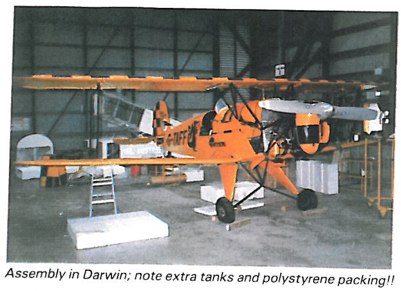
The rest of this report is written in diary format to make things easier for you to follow.
29th April 89 20:30 Z The jokes and fun have stopped. G-TAFF is stuffed to the brim with oil and fuel and I’m feeling apprehensive about 550 nautical miles over sea with a 10 knot headwind. The Australian TV crew have become a pain in the backside as I strap in, my numb brain makes me stumble through my checks. A final handshake with two great friends and the Tigre engine is fired up. From this time to U.K, the engine ran without a stutter and hand started easily every time -- well done Paul and Norvic! It’s always a wonder to me how, every time I fly, as the wheels stop going round all the worries fall off my shoulders, and I get on with the black and white of aviation. Six and a half hours of steer on my pathfinder compass saw me 15 miles off track over Timor looking for Kupang. Two hours of pratting around sees me airborne again and heading for Bali. The engine is not as smooth and I wonder about the 50 gallons of green dyed 100/130 fuel I’ve put in. With light fading fast I’m struggling against a headwind and divert to a local grass strip 40 miles short of Bali.
30th April 89 Airborne for Bali dodging tremendous localized thunder storms —I found myself 30 miles out to sea trying to get around these nasties when the fuel pressure gauge failed and the fan started windmilling. An hour of hand operating the wobble pump saw me thanking my maker as I finally arrived at Bali. The rest of the day was wasted in checking the filters and replacing the fuel pump which l wrongly thought had failed; when this didn’t solve the problem I rechecked the paper filter in the wobble pump. It had a greasy appearance and appeared difficult to blow through, though no dirt was evident. To this day I believe I was sold some form of fuel cocktail at Kupang. Without the filter the fuel pressure was OK and I was able to crack on.
1st May This saw me over the Java Plains going to Jakarta Halim for an overnight stop.
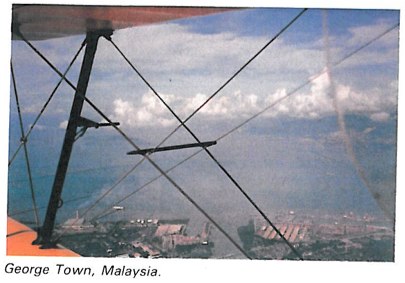
2nd May More Avgas 100/130 and on to Palembang in Northern Sumatra, over thousands of square miles of jungle. My handheld VOR had packed up, so it was with some relief I found the strip. Two hours of form filling saw me heading north for Singapore over incredible islands that looked like something out of a story book. Singapore radar took over 30 miles out and after a dance around the houses avoiding Changi, I poled into Seletar.
3rd May I spent most of this day hosted by Dowty Aviation, and repairing my 8 gallon tank which had developed a leak. At about 3 o’clock local I managed to get away, following the coast to Kuala Lumpur. Kuala Lumpur was efficient, polite and refused to charge me a landing fee.
4th May More coastline tracking to Phuket —a magic tropical land where I achieved a record for the whole flight by filling in 32 forms!
5th May This was to be one of my longest legs to Rangoon. It was 680 nautical miles and took seven and a half hours. Rangoon was the pits—six hours to get a transit visa to stay overnight and a street curfew between 2200 and 0600. The big plus was that the guy running the fuel had seen my telexes requesting clearance and had organised two barrels of 80/87—What a Star!
6th May First, a mountain range to cross, (Arak an Yoma), all above 8/8 cloud followed by a nervous let down based on time to find the West Coast of Burma. The crossing of the Bay of Bengal —which took about 90 minutes, was done on my turn and slip. This was because of the air pollution from Calcutta and was a taste of the type of goldfish bowl flying to come all the way to Europe.
7th May The temperature in Calcutta was 46°C so I was grateful to be airborne for Nagpur. My estimate for this leg based on wind forecast was 5.4 hours. The landscape was bland and featureless. The turbulence from thermals was extremely violent and on one occasion flicked the aircraft 30 short of inverted—incredible but true— I know —I was there! After six hours had elapsed I began to worry that I had missed Nagpur and was heading into desert country. I decided to make a precautionary landing and ask a policeman. After successfully landing on a dirt road I was inundated by hundreds of excited natives who threatened to crush the aircraft. Fortunately a policeman did appear! Beating off the locals with a stick and pointing to my location on the map. It seemed I was on track but 30 mites short of Nagpur, which meant an actual head wind of 20 knots, not 5 knots as forecast. A quick take-off with lots of dust and waving saw me in Nagpur 40 minutes later.
8th May The Indian Authorities weren’t impressed with my precautionary landing and, after signing a form in quintuple saying the aircraft wasn’t damaged, the best I could get was clearance for 0900Z departure the following day. I was hosted here by the “Nagpur Flying Club”, though they didn’t have two brass farthings to rub together; they cleaned the aircraft and helped me in any way they could. True aviation has no racial barriers.
9th May 0900Z Set off for Ahmadabad, red hot but a perfect cross country lasting 5.9 hours.
10th May Sunrise saw me taking off from India for Pakistan. The wastelands of Northern India were like the surface of the moon, a white, lifeless desert. 6.8 hours later saw me in Karachi helped in by radar.
11th May Two legs today, firstly along the coast to Gwadar in 4.3 hours. There was no Avgas at Gwadar, so with 150 ltrs. of regular I steamed south of Iran and followed parallel to its coast until I hit Muscat. I did this at 10,000 feet following airways as required, but with dust suspension in the air so bad that I was reduced to fly on the turn and slip for four and a half hours. By Muscat I’d had it! The CAA in London had briefed me to tune to 121.5 for this leg as this was the challenge frequency used by the American Navy! —Great. 5.8 hours from Gwadar saw me in Abu Dhabi as a guest of Emirates Air Services, who treated me like Royalty. (Thank you, Chris Miller!).
14th May After two days of waiting and telephoning. I finally got Saudi clearance. The Saudis were concerned about the durability of the Jungmann, and pointed out there had been problems with such epics previously. Eventually, the fact that I’d come a quarter of the way around the globe sank in, and at 12.25Z I was off up the Gulf of Bahrain. Going north abeam Muharraq I headed for Dharan in Saudi, only to hit the most appalling dust storms. Unable to maintain VFR I did a swift 180 and asked Dharan if I could divert to them (as per my flight plan). They wouldn’t have me at any cost because I had no diplomatic clearance so I opted for Bahrain (which Dharan cleared for me by landline). To add further to my problems my transmitter failed going into Bahrain but using the ICAO procedure in such circumstances (impressed?) I arrived there without any fuss. My wife sent out a spare radio (plug in type) via Qantas and it arrived in plenty of time for an early start on the 16th. (Incidentally, my 180 turn proved a good decision as Riyadh had 800 metres visibility in sand storms!).
16th May Two good legs were done, first to Riyadh and then Jeddah. The countryside was featureless with lots of sand and violent thermal activity. Landing fees were horrendous; $550 in Riyadh and $450 in Jeddah! At Jeddah I met ex-pat Robert Thompson who helped me with a puncture and even got the aircraft cleaned down for me.
17th May 0720Z Airborne for Luxor in Egypt, across the Red Sea over a 6000 foot mountain range and bingo—the River Nile, a shining jewel stretching down the length of Egypt. Fifteen minutes of tracking north and 6.8 hours later found me in Luxor. Virtually everybody in Luxor is on the make. I refused to pay any of the extras demanded by officials (including the Commander of the Security Guard!) and rollocked anybody who came near me with an outstretched hand! It worked, and although I lost an afternoon, I got away next morning at the crack of sparrow.
18th May 0300Z Followed the Nile to Cairo (my kind of flying) loving every minute, then on to Alexandria and my first sight of the Mediterranean. An hour’s turn around and I was airborne for Rhodes. I had a stiff head wind but hit Rhodes on the nail and felt quite pleased with myself, having done 12.3 hours flying.
19th May-22nd May My flying got easier as the bureacracy got less. My route took me from Rhodes to Athens in 4.1 hrs. (19th May), Athens-Napoli 7.3 hrs. (20th May), Napoli-Marseilles-Deauville 11 hrs. (21st May), Deauville-Southampton-Sherburn-ln-Elmet 4.6 hrs. (22nd May). My biggest hassle was getting through Upper Heyford!
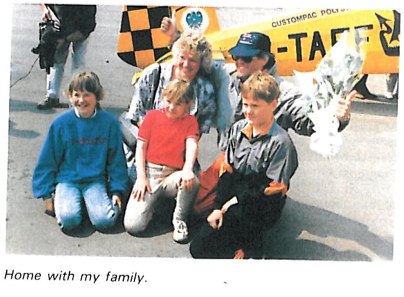
Conclusion At Sherburn, my family and friends were there to meet me with a home coming I shall always remember.
Was it worthwhile? Yes. I feel 100% better for it and 2 stone (28 lbs) lighter), a tremendous rewarding experience in return for sticking my neck out.
Would I do it again? No. Not with a 40 year old aircraft and no instruments. The risks are too high. (Remember our Amy Molison had a new machine and flew in a straight line). What’s next? —Well —Henshaw’s flight to the Cape and back was hot stuff, so I’ve got a bottomless pit if anybody wants to pour money into it!
Facts
A/c type—CASA 131EReg. No, —G-TAFF
Weight empty —1040 lbs.
Weight fully loaded—Heavy
Fuel used-960 gallons
Hours flown-136.6 hours
Distance covered-12,600 rim.
No. of engine revolutions —16.3 million
G-TAFF is now at my strip at Breighton. (Drop in if you are passing—PPR-0757 289065-pilot’s risk). What a machine—Neil Williams was right—NOTHING flies like a Bucker!
Postscript
Tony made good on his idea to recreate Alex Henshaw's famouse Cape flight in the Percival Mew Gull G-AEXF but it didn't go quite as planned due to engine issues. You can read all about it here: http://www.thecaperun.co.uk and encourage him to try again soon.

